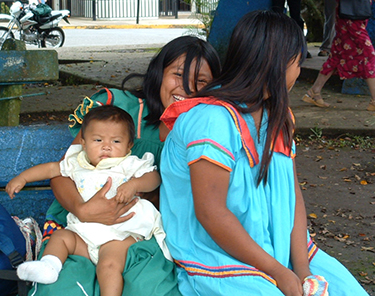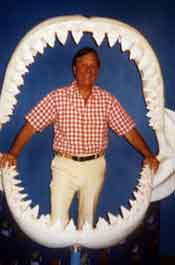CRUISE SHIP LECTURES :
The San Blas Cuna of the Panama
Dr John Augelli shares his insight on the The San Blas Cuna of the Panama in these notes from one of his cruise ship lectures.
THE SAN BLAS CUNA OF THE PANAMA

The Cuna Indians of the San Blas Islands of Panama constitute less than 2% of the country's total population, but in many ways they are among the best known and most colorful element in the multi-racial tapestry of the Isthmus. In fact, according to several anthropologists, Cuna identity is probably stronger than any other Indian group in Central America. Their success in cultural survival through adjustment to change has been such that they are serving as a model to other indigenous groups on the Isthmus. Why have the Cuna remained so distinctive? No one really knows for sure, but their history and habitat provide some clues.
History
The original homeland of the Cunas was in the interior valleys of Darien until the 18th century. Then they began fleeing from Spanish troops eastward towards the then-isolated and economically undesirable San Blas coast. To the Cunas, this tropical forest-covered coast with its intricate chain of corral islets became a refuge area where they could retain their racial and cultural distinctiveness. They adjusted to their new environment by becoming expert fishermen, using their canoes or cayucos for transport, making widespread use of the readily available coconut (milk and flesh), and continuing with slash-and-burn agriculture for crop production.
For centuries the relations between the Cunas and the Hispanic authorities were at best, one of aloofness and at worst, one of open conflict. The San Blas coast, like the rest of the littoral of Central America, became a frontier between the Spaniards who controlled the Isthmian interior and the English and other seafarers who often held sway along the coast. It was customary for the Cuna and other coastal Indians to side with the English in opposition to the Spaniards. For example, like the Misquito Indians further up the coast in Nicaragua, the Cunas refused to obey Spanish laws forbidding trade with outsiders; they cooperated with English pirates and illegal traders, and on occasion, they would even guide the English freebooters attacking Spanish settlements. It was not until well into the twentieth century that the Cunas and the Panamanian government began to reach limited accommodation.
Political
In the early decades of the 20th century, outsiders such as turtle hunters, rubber tappers, illegal Hispanic squatters, and government-sponsored missionaries, educators and police increasingly infringed on Cuna territory and the Indian's traditional way of life. The very existence of the Cuna as a people and of their territory as resource base were placed in jeopardy. Finally, fed up with these encroachments, in 1925, with the aid of an American adventurer named Richard Marsh, the Cunas launched a brief but successful rebellion. The Cunas defeated the local police force and when the national government sent reinforcements, U.S. military intervention halted any Panamanian retaliation. The uprising was followed by more than five years of negotiation until Panama recognized the San Blas islands and a segment of the adjacent coast as a native reserve for the Cunas in 1930. But this recognition of a territorial reserve did not allay the fears of the San Blas Indians. It took another eight years of prolonged political struggle with the national government before the Cuna territory and people were given the status of "comarca". (Comarcas are Indian homelands where there is internal administration of laws and social policies under the jurisdiction of the federal government. Although the comarca is both a geopolitical division with defined boundaries and an administrative system, it is not an independent state. Rather the national government recognizes the unique features of the Cuna society in contrast to the national one. The Indians accept certain national controls with reference to sovereignty, security and resource exploitation, but they make their own decisions concerning cultural, economic and some political matters affecting their territory.) Significantly, the Cuna were the first indigenous group in Panama to be granted the status of "comarca".
The San Blas Comarca consists of about one million acres of mostly (90%) forest land on the San Blas Islands and adjacent coast. The roughly 50,000 Cunas live in 60 villages in the comarca, but a small number continue to reside in the interior outside the comarca.
Within the comarca (Kuna Yala), traditional leaders fit into a
highly stratified political organization that includes chiefs (caciques), congresses, village leaders and legislators. In addition the San Blas Comarca or Cuna Yala now has its own federal legislators, representatives and lobbyists. (The Cuna political and social model has been so successful that Panama's other indigenous groups are trying to adopt it, under the guidance of Cuna advisors.)
Socio-Economic
The Cuna way of life continues to be based on a traditional subsistence economy, but with an increasing money component. The primary elements of subsistence are the production of food crops, such as corn, manioc, and plantains, using slash-and-burn farming techniques; raising domestic animals (pigs, chickens), fishing and some hunting.
The oldest "money" component of the Cuna economy has been the coconut, of which they produce some 25-million annually. In addition to using the fruit for its milk and flesh, the Indians sell or trade coconuts to meet their needs. The coconut trade has changed hands more than once. The original buyers were English, but they were replaced early this century by Panamanians. Beginning in the 1940s, boats from northern Colombia have dominated the trade, despite the efforts of the Panamanian government to curtail it in favor of Panamanian nationals. Cuna coconut sellers enjoy a relatively secure nearby market, and by trading strictly for cash, they avoid indebtedness. Also by trading with Colombia rather than Panama, they continue their time-honored practice of playing an outside power against the national government.
Two additional sources of money for the Cuna are the wages earned by Cuna men working in the Canal area, the banana plantations and elsewhere in Panama, or shipping out as sailors. Virtually every Cuna man spends a year or more of his life working and earning wages outside the Cuna community. But they always seem to come back. The most widely known money maker for the Cuna, of course, is the lively trade in the colorful tapestries called "molas" which Cuna women sew, and sell to tourists who visit their islands or Panama City. Since World War II, the Cuna have become increasingly involved with tourism. One-day trippers and cruise passenger ships predominate, but a small number of tourists make short stays at small resorts run by Cuna, Panamanian and Americans.
The increasing involvement with a money economy has largely eroded the self sufficiency that the Cuna once enjoyed. They are already dependent on outside sources for salt, sugar, rice, pickled meat and other food needs. Even more, they purchase from the outside tools, containers, cloth, utensils, canoe hulls, outboard motors concrete, paper and other manufactured goods. In the process, the traditional home skills that used to provide for some of the products (such as tools, utensils and canoe hulls) are being lost.
Increasing involvement in a money economy is also creating social stresses. Historically, there have been few Cunas who were either very rich or very poor. On an average, every family had its hut, its canoe or cayuco, a parcel of land to cultivate and its share of the palm groves. The sense of community was strong, and cooperation was well developed. People exchanged work to cultivate their land or to build houses etc. Although there were chiefs, there were few socio-economic distinctions. Every person (man or woman) was considered the equal of every other person--almost pure democracy. While many of these traditional social traits continue, differentiation is beginning to appear based on income, education and other factors that make for competition.
Cuna society is matrilineal, and women occupy a much more important position than they do in other indigenous groups. Women, for example, do much of the work and the marketing of molas, they own land and houses, and they make the major decisions affecting the household. When a man gets married, he is linked with his wife's family. Preference is actually shown for girl babies from the start. A Cuna saying is, "he who has a daughter acquires a son". When a girl reaches puberty, a big party is given. The girl parts her hair in the middle as a sign that she is ready to marry, and the initiative to wed is often taken by the girl through her father. Divorce is unknown, and Cuna households are large with the families of various daughters and their husbands.
Despite their comparative importance, however, Cuna society is not a matriarchy ruled by women. On balance women are subordinate to men who restrict their movements, behavior and social participation. There is no such thing as an outsider dating a Cuna girl. In fact the Cunas seem to have a hangup on maintaining racial purity. For this reason, no non-Cuna man may spend the night in a Cuna village, and in the very rare cases where there may be some question about a new-born child's paternity, the child seems to disappear.
Such attitudes inevitably lead to inbreeding with its negative biological consequences, including the frequent birth of albino children. These are called "children of the Moon" and are welcomed as bringers of special luck.
In retrospect, the Cunas seem to have retained their racial and cultural distinctiveness partially as a result of physical and culturally imposed isolation and partially through ability to adjust to change. The Cuna society of today, while retaining much of their distinctiveness, is a far cry than it was at the beginning of this century. Forces are at work, particularly as result of economic competition and education which may begin to eat away at the old way of life, and push the Cuna into the racial and cultural potpourri that characterizes the general population of Panama.

